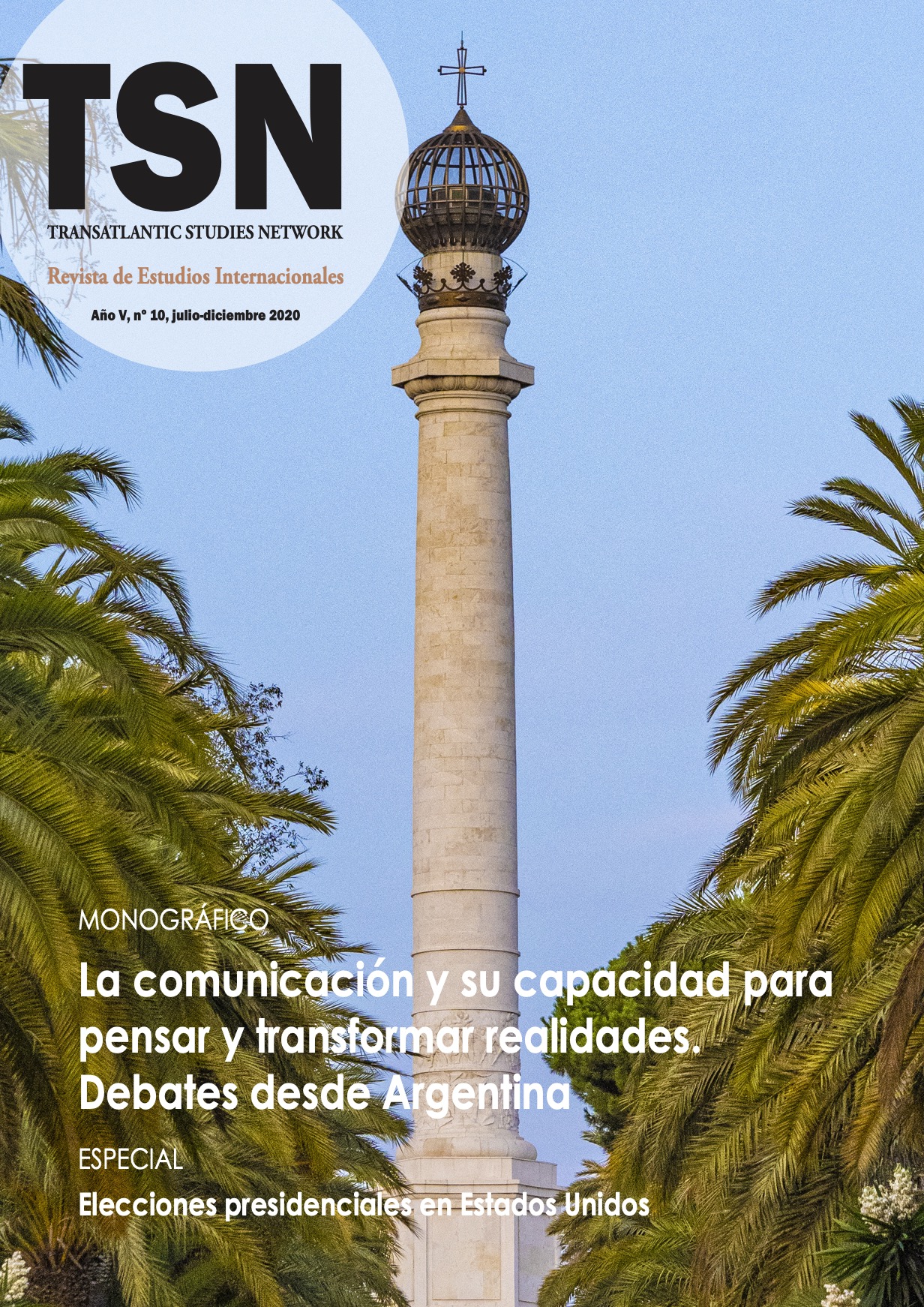National borders important to international trade in the province of Misiones?
DOI:
https://doi.org/10.24310/TSN.2020.vi10.13651Keywords:
International trade, border, gravity model, internal bias, anomaliesAbstract
In international trade, because «internal bias», countries tend to trade more within their borders than outside them. Likewise, there are factors that positively affect bilateral trade, such as with countries that share a language, adjacency or trade agreement. In this sense, these factors could contribute to reducing the border effect. This study addresses the problem of the border effect of Misiones, an Argentine province that has 90 % international borders (shared with Paraguay and Brazil). For the analysis, quasi-experimental quantitative approach was used with secondary data source and application of the theory of the gravitational model and econometric technique of the iterative version of the Zellner's Seemingly Unrelated Regressions (SUR) Model for the period 2007-2013. The results show that national borders are important for the Province of Misiones. However, regional belonging produces greater trade with those countries that share a language, land border, and economic agreement (The Mercosur).
Downloads
Metrics
References
Agnosteva, D. E.; Anderson, J. E.; y Yotov, Y. V. (2014): Intra-national trade costs: Measurement and aggregation (núm. w19872). National Bureau of Economic Research.
Anderson, J. E.; y Van Wincoop, E. (2003): «Gravity with gravitas: A solution to the border puzzle», en American Economic Review, 93 (1), pp. 170-192.
Anderson, J. E.; y Yotov, Y. V. (2010): «The changing incidence of geography», en American Economic Review, 100 (5), pp. 2157-2186.
Anderson, J. E. (2011): The Gravity Model. Boston College and NBER.
Balta, N.; y Delgado, J. (2009): «Home bias and market integration in the EU», en CESifo Economic Studies, 55 (1), pp. 110-144.
Banco de Desarrollo, B. I. (2002): Más allá de las fronteras: El nuevo regionalismo en América Latina: Progreso económico y social en América Latina: Informe 2002. Banco Interamericano de Desarrollo.
Banco Interamericano de Desarrollo, B. I. (2017): Los futuros del MERCOSUR: nuevos rumbos de la integración regional.
Belmartino, A. (2016): Diversidad industrial en las provincias argentinas y factores económicos asociados (1996-2012), (tesis doctoral). Universidad Nacional de La Plata.
Bereciartua, P. (2005): «Nueva geografía económica» y su relevancia para la Argentina.
Berrettoni, D.; y Polonsky, M. (2011): «Evolución del comercio exterior argentino en la última década: origen destino y composición», en Revista del CEI. Comercio Exterior e Integración, núm. 19.
Bouzas, R.; y Fanelli, J. M. (2002): Mercosur: integración y crecimiento, núm. 337.91/B78m.
Chagnkyu, C. (2002): «Linder hypothesis revisited», en Applied Economics Letters, 9, pp. 601-605.
Chen, N. (2002): «Intra-national versus International Trade in the European Union: Why do National Borders Matter?», en CEPR Discussion Papers, núm. 3407.
Comisión Económica para América Latina y el Caribe (2016): Panorama de la inserción internacional de América Latina y el Caribe. La región frente a las tensiones de la globalización.
Comisión Económica para América Latina y el Caribe (2017): Perspectivas del comercio internacional de América Latina y el Caribe.
Correa Alsina, F. (2011): «La dinámica del empleo en la frontera norte de Uruguay», en Estudios fronterizos, 12 (23), pp. 79-93.
Coughlin, C. C.; y Novy, D. (2013): «Is the international border effect larger than the domestic border effect? Evidence from US trade», en CESifo Economic Studies, 59 (2), pp. 249-276.
De Cicco, J. A. (2010). Características y determinantes del comercio intraindustrial argentino. Período 1992-2007 (tesis doctoral). Universidad Nacional de Mar del Plata.
De Ménil, G.; y Maurel, M. (1994): «Breaking up a customs union: the case of the Austro-Hungarian Empire in 1919», en Review of World Economics, 130 (3), pp. 553-575.
De Sousa, J.; y Poncet, S. (2011): «How are wages set in Beijing?», en Regional Science and Urban Economics, 41 (1), pp. 9-19.
Deardorff, A. (1998): «Determinants of bilateral trade: does gravity work in a neoclassical world?», en The regionalization of the world economy, pp. 7-32. University of Chicago Press.
Delanty, G. (2008): «Fronteras: Transitoriedad y dinámicas interculturales», en Revista CIDOB d'Afers Internacionals, pp. 82-83.
Eaton, J.; y Kortum, S. (2002): «Technology, geography, and trade», en Econometrica, 70 (5), pp. 1741-1779.
Ehrenberg, R. G.; y Smith, R. S. (2012): Modern Labor Economics: Theory and Public Policy, Donna Battista (ed.). Boston: Pearson Education, Inc. https://fac.ksu.edu.sa/sites/default/files/Modern_labor_economics__theory_and_public_policy_0.pdf
Evenett, S. J.; y Keller, W. (2002): «On theories explaining the success of the gravity equation», en Journal of Political Economy, 110 (2), pp. 281-316.
Fally, T.; Paillacar, R.; y Terra, C. (2010): «Economic geography and wages in Brazil: Evidence from micro-data», en Journal of Development Economics, 91 (1), pp. 155-168.
Fischer, R. (2009): Curso de Comercio Internacional MGPP. Dpto. Ingeniería Industrial, Universidad de Chile.
Frankel, J.; Stein, E.; y Wei, S. J. (1995): «Trading blocs and the Americas: The natural, the unnatural, and the super-natural», en Journal of Development Economics, 47 (1), pp. 61-96.
Freaza, M. A.; e Ibarra, Z. N.: Indicadores económicos de la provincia de Misiones.
García, B. F. (2008): «Fronteras sociodemográficas de la Unión Europea», en Las Fronteras Exteriores de la Unión Europea, pp. 19-56. Instituto Español de Estudios Estratégicos.
García Alonso, P. L. (2017): Integración del efecto frontera y la resistencia multilateral en las medidas de accesibilidad: una herramienta para la evaluación de proyectos de infraestructuras de transporte (tesis doctoral). Universidad Complutense de Madrid.
Gasparini, C. (2014): Integración regional y cooperación en el Mercosur. Avances, retrocesos y oportunidades. Documento de trabajo, 1.
Gil-Pareja, S.; y Llorca-Vivero, R. (2017): «El comercio exterior de España y el proceso de integración europea», en Estudios de Economía Aplicada, 35 (1), pp. 63-83.
Guarrochena de Arjol, M. G.; y González, S. N. (2015): «Medição da Complementaridade do Comércio sectorial para a Integração Produtiva da Argentina e do Brasil», en Interfaces Científicas-Humanas e Sociais, 3 (3), pp. 27-40.
Head, K. (2003): Gravity for beginners. University of British Columbia, 2053.
Head, K.; y Mayer, T. (2002): Illusory border effects: Distance mismeasurement inflates estimates of home bias in trade, vol. 1. París: CEPII.
Helliwell, J. F. (1995): Do national borders matter for Quebec's trade? (núm. w5215). National Bureau of Economic Research.
Helliwell, J. F. (1997): «National borders, trade and migration», en Pacific Economic Review, 2 (3), pp. 165-185.
Hering, L.; y Poncet, S. (2010): «Market access and individual wages: Evidence from China», en The Review of Economics and Statistics, núm. 92 (1), pp. 145-159.
Hess, B. (2005): The Home-bias-in-trade Puzzle: The Case of China. Inst. of World Economics.
Instituto Nacional de Estadística y Censos (2016): Cuentas nacionales: metodología de estimación: base 2004 y serie a precios constantes y corrientes, 1.ª ed. Ciudad Autónoma de Buenos Aires: INDEC.
Isard, W. (1954): «Location theory and trade theory: short-run analysis», en The Quarterly Journal of Economics, pp. 305-320.
Jaramillo, D.; Calá, C. D.; y Belmartino, A. (2016): Especialización industrial en Argentina: patrones provinciales y evolución reciente (1996-2014), núm. 2743. Universidad Nacional de Mar del Plata, Facultad de Ciencias Económicas y Sociales, Centro de Documentación.
Joši?, H.; y Joši?, M. (2016): «Alternative measures of internal distance in estimating home bias in trade: the case of Croatia», en Ekonomska Istrazivanja, 29 (1).
Krugman, P. R. (1991): Geography and trade. MIT Press.
Krugman, P. R.; Obstfeld, M.; y Melitz, M. J. (2012): Economía internacional: teoría y política.
Lima, J. E. D.; y Álvarez, M. (2008): Indicadores de comercio exterior y política comercial: mediciones de posición y dinamismo comercial.
Linares, M. D. (2013): «La frontera entre la permeabilidad y el “piquete”. Las transformaciones socio-territoriales en el paso Posadas (Argentina)-Encarnación (Paraguay) durante la década del noventa», en Revista Transporte y Territorio (9), pp. 39-63.
McCallum, J. (1995): «National borders matter: Canada-US regional trade patterns», en The American Economic Review, 85 (3), pp. 615-623.
Mendoza J. et al. (2008): La importancia del comercio internación en Latinoamérica. México: Universidad Autónoma de Tamaulipas.
Mendoza Marriott, R. E.; Verdezoto, N.; y Yanina, S. (2007): Análisis del comercio bilateral por bloques usando un modelo gravitacional aumentado período 1980-2003 (tesis de licenciatura).
Mesanza, R. B. (2006): «Medición de la complementariedad comercial. España frente a la Europa oriental comunitaria», en Boletín Económico de ICE (2878).
Minondo, A. (2003a): «Comercio internacional y efecto frontera en el País Vasco», en Revista de Economía Aplicada, 11 (32), pp. 115-131.
Minondo, A. (2003b): «¿Existe un sesgo regional en el comercio?: Un análisis para el País Vasco», en Ekonomiaz: Revista Vasca de Economía (54), pp. 170-179.
Minondo, A. (2007). «The disappearance of the border barrier in some European Union countries' bilateral trade», en Applied Economics, 39 (1), pp. 119-124.
Moncada, M. (2016): «La cuestión catalana: efecto frontera», en Anuario Jurídico y Económico Escurialense (49), pp. 295-334.
Monge, R. A.; y Giró, J. E. (1996): Regresiones que aparentemente no están relacionadas (SUR).
Mouchart, M. (2004): The econometrics of panel data. Institute of Scientific Catholic University of Louvain.
Nitsch, V. (2000): «National borders and international trade: evidence from the European Union», en Canadian Journal of Economics/Revue Canadienne d'Économique, 33 (4), pp. 1091-1105.
Obstfeld, M.; y Rogoff, K. (2000): «The six major puzzles in international macroeconomics: is there a common cause?», en NBER Macroeconomics Annual, 15, pp. 339-390.
Olamide, E. I.; y Adepoju, A. A. (2013): «Estimating seemingly unrelated regressions with first order autoregressive disturbances», en Studies in Mathematical Sciences, 6 (2), pp. 40-57.
Organización Mundial del Comercio (2013): Informe sobre el comercio mundial: Factores que determinan el futuro del comercio. Ginebra: OMC.
Organización Mundial del Comercio (2014): Informe sobre el comercio mundial 2014. Comercio y desarrollo: tendencias recientes y función de la OMC.
Organización Mundial del Comercio (2017): Examen estadístico del comercio mundial 2017.
Oviedo, J. M. (s/d): Metodo SUR. Implementación en: Maple, Mathematica, Gauss, Matlab y Excel.
Pacchioli, C. (2011): «Is the EU internal market suffering from an integration deficit?, en CEPS Working Documents.
Parsley, D. C.; y Wei, S. J. (2001): «Explaining the border effect: the role of exchange rate variability, shipping costs, and geography», en Journal of International Economics, 55 (1), pp. 87-105.
Poncet, S. (2003): «Measuring Chinese domestic and international integration», en China Economic Review, 14 (1), pp. 1-21.
Qian, Z. (2007): FDI and European Economic Integration (tesis de máster). MA Economics of International Trade and European Integration. Mimeo.
Ríos, M. S.; Solé, T. T.; y Perdiguer, M. F. (2008): «La intensidad comercial de la industria catalana con el resto de España y la Unión Europea. Capacidades y potencialidades», en Boletín Económico de ICE (2952).
Rogers, J. H. (1996): «How wide is the border», en The American Economic Review, 86 (5), pp. 1112-1125.
Samuelson, P. A. (1954): «The transfer problem and transport costs, II: Analysis of effects of trade impediments», en The Economic Journal, 64 (254), pp. 264-289.
San Román, V. M.; Calvo, M. B.; y Rute, B. S. R. (2012): «European Union and trade integration: does the home bias puzzle matter?», en Revista de Economía Mundial (32), pp. 173-188.
Sánchez, J. Z. M.; y Aldana, C. M. (2008): «Paul Krugman y el nuevo comercio internacional», en Criterio Libre (8), pp. 73-86.
Shahriar, S.; Qian, L.; Kea, S.; y Abdullahi, N. M. (2019): «The gravity model of trade: A theoretical perspective», en Review of Innovation and Competitiveness: A Journal of Economic and Social Research, 5 (1), pp. 21-42.
Starck, S. C. (2012): The theoretical foundation of gravity modeling: What are the developments that have brought gravity modeling into mainstream economics (tesis de máster). Department of Economics, Copenhagen Business School.
Valhondo de la Luz, J. V. (2010): «Reflexiones sobre el concepto de fronteras», en Etnicex: Revista de Estudios Etnográficos (1), pp. 133-145.
Vancauteren, M. (2002): The impact of technical barriers to trade on home bias: an application to EU data. Universite Catholique de Louvain.
Walsh, K. (2006): Trade in services: does gravity hold? A gravity model approach to estimating barriers to services trade.
Wei, S. J. (1996): Intra-national versus international trade: how stubborn are nations in global integration? (núm. w5531). National Bureau of Economic Research.
Zellner, A. (1962): «An efficient method of estimating seemingly unrelated regressions and tests for aggregation bias», en Journal of the American Statistical Association, 57 (298), pp. 348-368.
Zellner, A.; y Huang, D. S. (1962): «Further properties of efficient estimators for seemingly unrelated regression equations», en International Economic Review, 3 (3), pp. 300-313.
Zellner, A. (1963): «Estimators for seemingly unrelated regression equations: Some exact finite sample results», en Journal of the American Statistical Association, 58 (304), pp. 977-992.
Downloads
Published
How to Cite
Issue
Section
License

This work is licensed under a Creative Commons Attribution-NonCommercial-ShareAlike 4.0 International License.



























